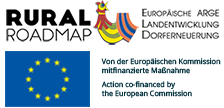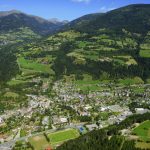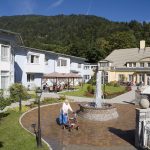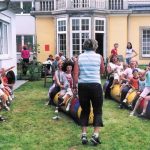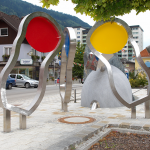Radenthein, Carinthia, Austria
The municipality Radenthein lies at the intersection of the valleys of the streams Kaning, Tiefen and Feld and has approx. 6,700 inhabitants, 2,500 of which live in the main village while the rest is spread over several villages.
Radenthein owes its rise to national importance to mining. Already in the late middle ages there are reports of gold diggers; the first hammer mill to process iron originates from the 18th century. At the beginning of the 20th century the mining and processing of magnesite was begun. RHI (Radex-Heraklith-Industriebeteiligung AG) is the leading industrial company of the region which in its heyday employed 3,000 people. In the nineties there were 1,200 still working in this industry, today there are only 400. Although RHI is still the largest employer in the region this decrease in jobs lead to grave changes: Earlier self confident as an important economic factor on the Austrian market, a “social depression” evolved due to the rapid spread of unemployment and the lack of future perspectives.
Out of this state of emergency several lighthouse projects driven by a group of committed citizens were implemented, especially in the social area, that energetically counteracted the prevailing negative mood. The club VitaminR ( Active with another in Radenthein) was an important foundation pillar for this. For instance it created “Gesunde Dorf” (healthy village) whereby health represents an expression of a new self confidence, an important basis for living for everyone and also as a foundation for new jobs.
From this group came also the AHA ( a different kind of house for the old).The converted housing and farm buildings of a noble villa of the industrial era that were used now houses an old people’s home, space for supported flats, a kindergarten including childcare that have been put together as a communal living area for old and young. A cafe that is open to all has been integrated as a meeting place for all generations. A further initiative is the „Männerfrühstück 50+“ (breakfast for males over 50 ) whose goal is – accompanied by external moderators – coping with the future of this group (often unemployed/early retirees). A future project still in planning is more intensive youth work. A private initiative is TRiK, Therapeutic Riding in Carinthia for mentally handicapped children.
To be highly acclaimed is that in the meantime in Radenthein a barrier-free design of public places has been realised. In conjunction with the trade and businesses this achieves an enormous added value to the village that also increases the attraction of the shops in the village centre. Interesting is the end-to-end artistic design with the artificial figure of a “radish” that appears in different forms in different places representing a special identity feature and that inspires individual interpretations.
A remarkable, publicly effect community project is the adventure world Granatium that was recently opened. For this an old, empty industrial site of a former local clothing company was converted into a museum with garnet as its theme. The substantial costs to build this new adventure centre are partially being covered by donations from local companies. Another very expensive project with high artistic pretensions is “Sagamundo”, the “House of Sagas”. The hope is certainly justified that this “Lighthouse” project, subsidised by leader resources, will trigger impulses to visit the town of Radenthein.
Farming is performed by approx. 50 full-time farms that farm grassland and forests under difficult conditions (positioned on slopes, small structured). Although signs of direct marketing can be seen. Along the Kaningbach different natural leisure areas have been created with Kneipp facilities, mills, barbecues etc.
Regional planning and architecture do not have at the moment great significance due to the lack of settlement pressure but could find new tasks in the modification of town planning to cover the needs of building areas for future generations.
The municipality Radenthein, that is involved in different national programmes, convinces with excellent projects, especially in the social area, that counteract the negative mood after the fall of the local industry. With the commitment of key persons a reversal was achieved that gave the citizens a footing and new perspectives for the future. Also the initiatives of the municipality in conjunction with local businesses are noteworthy. Thereby the village receives a new modern image, an appeal to holidaymakers in the region is created and not least a contribution to economic vitalisation is provided.
Evaluated: 2008
